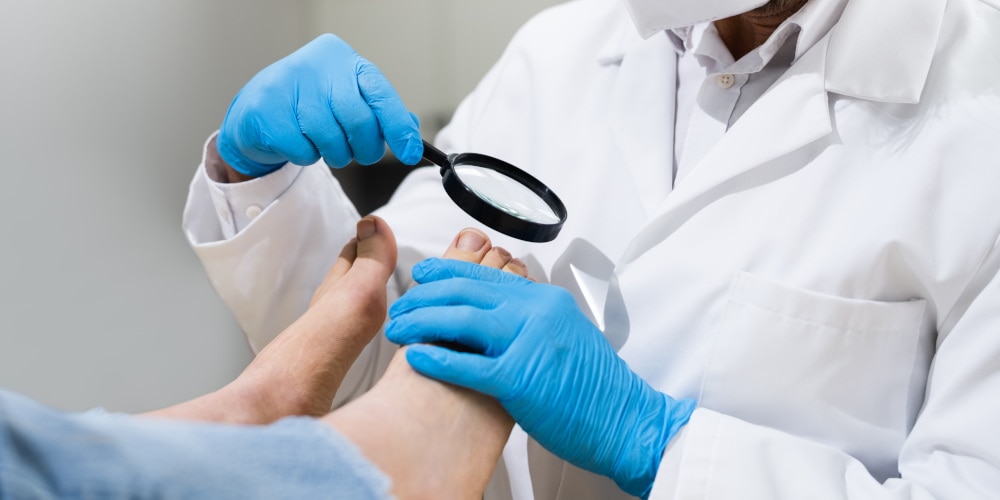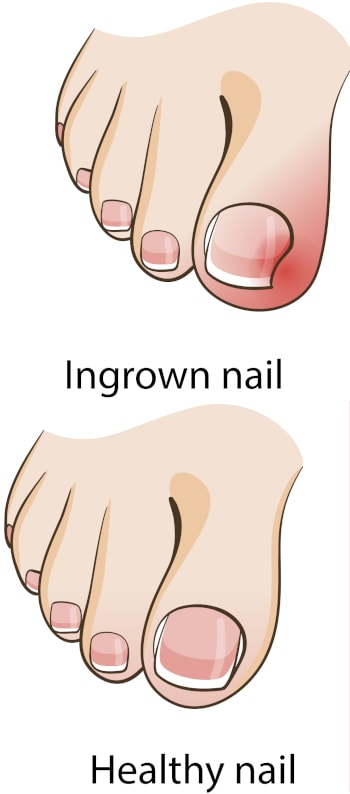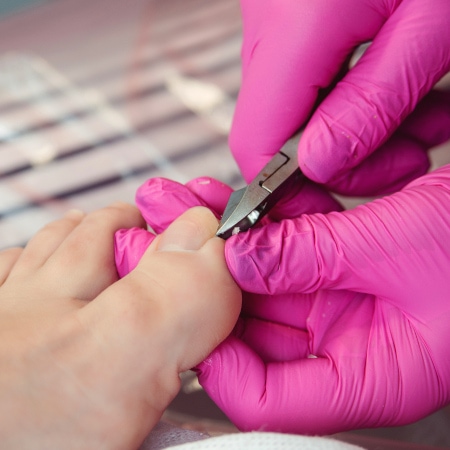Ingrown toenails are common and painful, but they don’t exactly sound like a life-threatening emergency. Most of the time, they are a passing warning issued during a pedicure – and therefore, most people think that a sturdy file is all that will ever be needed to correct it.
And yet, every once in a while, ingrown toenails require analgesics (pain relievers) or even surgery. So what are the signs that you may need a more aggressive ingrown toenail treatment?

What is an ingrown toenail?
Medically termed onychocryptosis, an ingrown toenail is when the edge of your toe nails grow downwards, puncturing the skin on your nail bed. It is particularly common in the big toe.
As it continues growing, the ingrown nail will embed itself further into the toe, pushed by your body weight. This is painful, especially when you are standing or walking.
Other common ingrown toenail symptoms include redness and warmth around the area. As it progresses, you may spot a bright red or black bruise at the edge of the nail, right around the puncture site.
The spot where the nail breaks your skin counts as an ongoing, if tiny, open wound. This is why the most considerable risk with ingrown toenails is infection. When this happens, expect to see:

Common causes of ingrown toenails
The leading cause of ingrown toenails is improper foot care – essentially, not visiting your podiatrist or trimming your toenails often enough. Cutting nails too short or leaving the corner of the nail square (rather than filing the edges) also makes ingrown nails more likely.
Other factors that make ingrown nails more likely include wearing too-small shoes (especially those pointy models that were fashionable a few years ago) or even the natural shape of your toenails. Athletes constantly pounding the pavement, teachers, nurses, and anyone who spends a lot of time on their feet will also be at a higher risk of developing an ingrown toenail.
In very rare cases, ingrown toenails happen suddenly, after banging your toe just in the right place or having a hefty weight fall on top of it.
Can I treat my ingrown toenail at home?
Yes, sometimes, provided it is still in its early stages. Whenever you (or your pedicurist) first notice the early symptoms of an ingrown toenail, there are a few home remedies you can try.
- First, soak your feet in warm water, with Epsom salts if possible, for at least 10 minutes every day. This will soften the nail and make it less sharp.
- If the damage is very superficial, you can try to file away the offending nail edge. It’s best if someone helps you with this, as it will lessen the chances of accidentally cutting your foot.
- Apply an antibiotic cream or ointment around the area.
- Take an anti-inflammatory pain reliever, such as Acetaminophen (Tylenol) or Ibuprofen (Advil).
If possible, try to wear open-toe sandals or wide shoes for a few days.
But what about the nail itself? Should you just cut it?
Please don’t. Unless you are an advanced yoga master or a contortionist, it’s best not to attempt an ingrown toenail removal at home. You won’t be able to reach the right part of the nail comfortably, and you may do more harm than good.
Book an appointment with a podiatrist who will be able to use an appropriate and sterilized ingrown toenail removal tool from the right angle.
When to seek medical attention for an ingrown toenail?
If there are any signs of infection, then your ingrown toenail has surpassed the capabilities of over-the-counter or home remedies. Signs of infection include severe pain, redness, warmth to the area, swelling, and any pus or discharge coming from the nail.
In addition, if you have already tried an antibiotic ointment or any of the home remedies above, but the pain only got worse, it’s best to see a doctor.
Finally, if you have diabetes, peripheral nerve damage, or circulation problems, you will be at a high risk of hard-to-treat infected ingrown toenails. Best to contact a specialist right away!
Who to see a doctor for an ingrown toenail?
There is a bit of a general misunderstanding about the qualifications for an ingrown toenail specialist.
While a pedicurist can easily spot the condition, they are not really qualified to treat it. They will not be able to prescribe any antibiotics or remove the toenail safely. If they don’t sterilize their tools properly, you could end up with a bigger problem, such as a fungal infection, in the surrounding skin.
The right specialist would be a Doctor in Podiatric Medicine (DPM) or podiatrist. Podiatry is a branch of surgery specializing in all foot-and-ankle problems – from toenail infections or cellulitis to plantar fasciitis.
Can I go to urgent care for an ingrown toenail?
If you notice signs of an infection, especially yellow or foul-smelling pus, or you get a fever – then yes, head to urgent care and have a doctor take a look. They will probably refer you to a podiatrist for the definitive treatment, but if an infection gets this bad, that takes priority.
Ingrown toenail procedures: what will the doctor do?
Most of the time, any doctor or podiatrist will begin by treating the infection. This is usually done with antibiotics.
In severe cases where the nail has gone deep into the toe, surgery may be necessary. This will involve removing either the sides of the affected nail or the entire nail on that toe.

This is a relatively simple procedure that can be done with a local aesthetic (a numbing agent that will ensure you feel nothing during the procedure). You will be awake for it and be home later that day.
If you’ve had ingrown toenails before or have another pre-existing condition that could complicate them (like poor circulation or foot deformities), the removal will be followed by ablation. This means we will use a solution to harden the exposed part of the nail bed to prevent the toenail from growing back in that direction. This will prevent ingrown toenail complications, but it’s not always necessary.
Recovering from a toenail removal is, unfortunately, not as quick. You may need to stay off your feet the next day and avoid long walks, jogs, or tight shoes for two weeks.
Where can I get an ingrown toenail removal near me?
University Foot and Ankle Institute is staffed by a team of experienced DPMs and surgical nurses. We have access to the latest technology and a comfortable, state-of-the-art healthcare facility where we can perform these surgeries without the stress of a regular hospitalization.
We are regional leaders in treating and researching foot pain, stability and gait issues, arch conditions, and feet injuries – from Achilles’ tendons to recurrent ingrown toenail infections.
University Foot and Ankle Institute is conveniently located throughout Southern California and the Los Angeles area. Our foot doctors are available at locations in or near Santa Monica, Beverly Hills, West Los Angeles, Manhattan Beach, Northridge, Westlake Village, Valencia, and Santa Barbara.
Call us at (877) 736-6001 for a consultation or make an appointment online now.
- Flip-flops Causing You Pain? Protect Your Feet This Summer! - April 23, 2024
- 9 Running Tips from Sports Medicine Experts - November 8, 2023
- Common Foot Problems In Aging Feet: What To Watch Out For - October 16, 2023